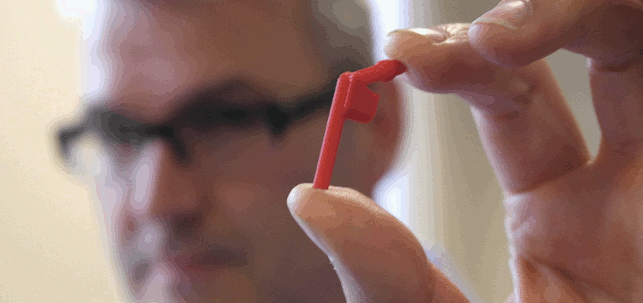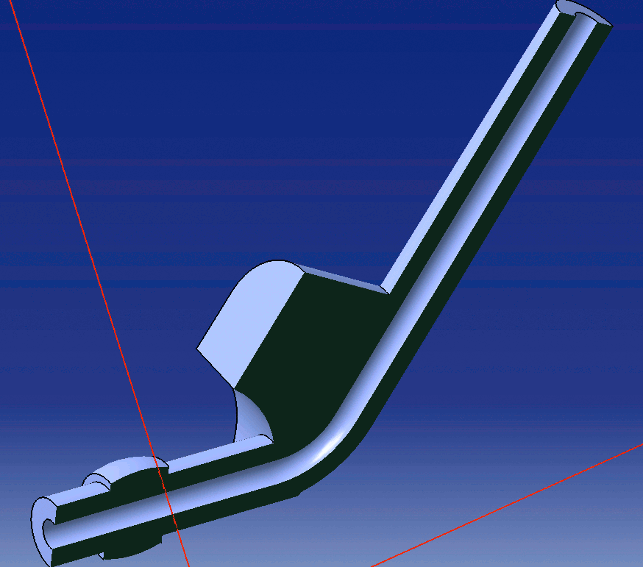When considering how many hundreds of thousands of components are contained within an aircraft it’s crazy to think that one tiny part, a part smaller than your little finger, could ground a plane by causing the misting up of cabin windows. However, the BAE 146 jetliner would have been an AOG (aircraft on ground) if spares of the obsolete cabin window breather pipe could not be made, and quickly.

The 3D printed window breather pipe for use on the BAE 146 aircraft
Replacing obsolete parts is something BAE Regional Aircraft in Prestwick is experiencing more of and it’s not just for its own in-service fleet. As an integrated solutions provider, it supplies parts for third party aircraft types too.
The original method of producing these parts was injection moulding but the tooling had become damaged. The solution, due to its quick turnaround and small batch manufacturing capability, was 3D printing.
3D printing — or using the more archaic term of rapid prototyping — is by no means a new technology and aerospace manufacturers have been using it for decades to produce prototype parts for testing and analysis. It’s only recently that the industry has started to consider using this method as a means to manufacture end use products.
However, the potential barrier has been that getting a part onto an aircraft requires a certification process, often deemed to be complex and lengthy.
Nevertheless, Philip Beard, structures support manager at BAE Systems Regional Aircraft, and his team were keen to pursue 3D printing especially as the tooling for the breather pipe was no longer available and new tooling would cost in the region of £14,000, not to mention how long it would take to get the part manufactured thereafter.
Lending a hand
Although the team didn’t have any 3D printing expertise inhouse, they had the resources of their colleagues over at the BAE Systems Military Air & Information (MA&I) business in Warton, Lancashire, who have been experimenting with 3D printing technology for many years at their Centre Of Excellence.
In fact, they had recently flown a 3D printed metal camera bracket for the first time on board a Tornado fighter jet during a test flight. Having demonstrated the capabilities of its selective laser sintering (SLS) machine, a form of 3D printing or additive manufacturing that builds plastic objects layer-by-layer, it was decided that this was a suitable method to produce the breather pipe.
“With time of the essence, we were at the point where we either go down the injection moulding route of getting the new injection tool made, approved and then for it to actually produce a part, or 3D printing, which would take a matter of weeks. We went for 3D printing and for something that could have taken up to six months took just four weeks. And now that we know the process that can be reduced ever further in future,” explains Beard.

A Catia drawing of the breather pipe part, which was converted into an .stl file and sent to the 3D printer
“Another spin off that we found,” adds his colleague Graham Smith, head of business development at BAE Systems Regional Aircraft, “is the administration is a lot easier to manage. Previously, we would have had people go down and visit the manufacturer for first article inspections of the mouldings but a lot of this is not necessary now because you are just sending files electronically, which simplifies the administration effort.”
Beard supplied his Warton colleagues with the CAD drawings of the breather part as a CATIA file, who then converted it into an .stl and sent it to the SLS machine.
“Because we were involved with our MA&I colleagues, the first thing we did was send the file to them and have them make a part so that we could then prove to ourselves that this was the right technology and we’d be happy to do a certification process,” says Beard.
Gaining approval
With the part in hand, they then went about obtaining a European Aviation Safety Agency (EASA) Form 1 certification approval. “To get an aircraft part onto an aircraft it has to go through our 21J, which is our design office approval, and our 21G, which is our part approval.
Having both of them allows us to then issue the part so it can be released to get onto an aircraft, which is covered in EASA Form 1,” explains Beard.
“Additionally, under the approvals that EASA has granted us, it’s not just limited to our own aircraft but any fixed wing aircraft type.” Smith adds, “This stands us apart from a lot of the aerospace industry in that we’ve actually got a certified flying part that can be used on in-service aircraft.”

BAE Systems managed to manufacture the part with an EASA Form 1 approval
With the part ready for batch manufacture, their Warton colleagues introduced them to the additive manufacturing service provider 3T RPD in Newbury, which they had utilised in the past. Using its SLS machines, 3T produced a batch of 300 breather pipe parts in a nylon material.
“Not only was there the significant time saving and the avoidance of the tooling cost, but the actual parts cost 60 per cent less than the traditional method,” says Beard. “That’s the other beauty — it’s a relatively small quantity.
To make injection moulding anywhere economic even if you have the tool you have to be manufacturing in thousands. So again, for an aircraft that is no longer in production where you are looking to make small batches — this process then starts to lend itself,” he adds.
Taking stock
The 300 parts are now in stock at BAE Systems Regional Aircraft’s Weybridge spares warehouse and are being shipped to customers for use on in-service aircraft.
Having gained this experience, Beard and his team are now able to not only design or source replacement parts, but arrange their manufacture, obtain certification and then provide aftermarket support too. However, Beard is cautious about lavishing too much praise on just one technology solution amongst many and especially one that is still developing.
“This technology offers a potential solution for aircraft parts that are prone to obsolescence, where tooling is unavailable, for quick turn rounds and also for small batch production. It may not be the solution for every part, but where appropriate, it provides a faster route from design to completed parts meaning operators get the parts cheaper and quicker,” he says.
But he does see the potential of this technology as its capabilities continue to advance not only in printing in plastics but especially in various metals.
“At the moment our imaginations are 50 years ahead of where the technology is. So, currently you can’t print an entire aircraft wing but it will happen. Maybe a mirror to look at is carbon fibre. If you go back 30 years people were very comfortable making small parts in it but were not very comfortable making large parts. But today you have entire aircraft being made out of it,” explains Beard.
“I think we’ll see something in parallel, it’s just the timeframe that will be a lot less. So, the only thing now is technology keeping up with where we want to go.”
The rise of metal additive manufacturing
As much as 3D printing in plastics is an established technology in the aerospace industry, 3D printing in metal, otherwise known as metal additive manufacturing (AM), is rapidly advancing and heralding changes in how end-use parts are manufactured.
Many aerospace manufacturers and suppliers, including Boeing, BAE Systems, Airbus and Rolls Royce, are experimenting with and researching metal AM techniques. For instance, Boeing for its larger components is looking at a process called electron beam freeform fabrication, or EBFFF. This layer additive process uses an electron beam and a solid wire feedstock to fabricate metallic structures.
Meanwhile BAE Systems, together with researchers at Cranfield University, has created one of the largest 3D printed metal parts measuring 1.2m using a Wire and Arc Additive Manufacture (WAAM) process. This titanium spar section sits longitudinally to form part of an aircraft wing structure on a military aircraft.
But whilst these and other manufacturers are using metal AM methods to produce prototype parts to perform form, fit and function tests, there are some that have progressed to using it to produce final products.
One such company is MTU Aero Engines in Munich which, as of May 2013, is using its EOS selective laser melting (SLM) machine to manufacture casing attachment parts for the geared turbofan engines.
These components, made of EOS NickelAlloy IN718, are borescope bosses for the PurePOwer PW1133GJM low-pressure turbine (LPT) casing and allow borescope inspections to be be carried out.
MTU claim that the PW1133G-JM LPT is the first production turbine to feature borescope bosses made using SLM.
“The SLM process has been used at MTU on a number of technology projects. After all, the process holds great promise of offering new design options,” says Dr. Karl-Heinz Dusel, senior manager rapid technologies at MTU Aero Engines.
“It speeds up innovation cycles, permits lighter and more functional components to be produced, and brings down development and manufacturing costs. It shortens delivery times and allows tool reduced production of components with new complex designs that are extremely difficult if not impossible to manufacture using conventional methods.
The flexibility of the process also makes it particularly suitable for low-volume production and for one-off components.” However, one company that will be using metal AM for high-volume production is the global corporation General Electric (GE), which announced last year that it will mass manufacture a fuel nozzle for its newest jet engine, the CFM Leap, using metal AM machines.
These critical metal-alloy parts are due to go into planes in late 2015 or early 2016 and will be produced in-house at its Cincinnati division following an alleged $100 million dollar investment in an additive manufacturing facility.
GE is now boldly referring to additive manufacturing as the next chapter in the industrial revolution.
3D printing enables BAE Systems batch manufacture aircraft components
Default






